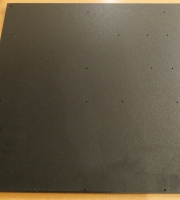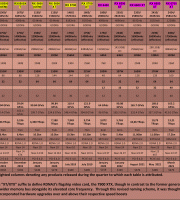


Asus X99-WS/Asus Rampage V Extreme.
Both of Asus’s maternal marvels accommodated a pair of Sata Express connectors, one wired to the main chipset, the second to an Asmedia controller. Owing to reverse compatibility, this formed swathe of 12 SATA III 6GB ports.
Every other Asus x99 based board (all 99999999999999 of them) also incorporated a propriety “OC”2011-3 socket, ingeniously engineered via six additional pins to circumnavigate the Haswell’s built in voltage regulator and provide a healthy wattage bonus to the CPU and memory. The result? Yet more record ravaging over-clocking.
Gigabyte GA-X99 SOC Force.
A questionable colour scheme, but admirably crafted bandwidth . All 40 lanes from the CPU could be utilized to cater for three and four way GPU setups, amending their traditional bandwidth quotas of 8/8/16 and 8/8/8/8 to 8/16/16 and x8/x16/x8/x8 respectively. Thus we discover why Gigabyte chose to initialize their M.2 port via the PCH instead of the processor. Those four spare lanes were essential to activate this feature.
EVGA X99 Classified
Winter 2013 brought EVGA mixed reception for its heavily hyped x79 “DARK”, which could in hindsight be described as a cynical attempt to distract new customers from the bitterness encompassing adopters of its three forerunners, none of which at the time had received an Ivy-Bridge BIOS and were beset with hindrances the company in fairness, eventually addressed.
The belated flagship drifted onto the shelves several months in advance of Asus’s similarly styled but infinitely more polished and acclaimed Rampage IV “Black”.
Speaking as the owner of what is traditionally cited as the most bug ridden and sloppily marketed product ever to evolve from EVGA’s expertise – my flawed genius, the SR-X – I should be compelled to agree with the above theory and condemn them for far worse, though I’ve never believed such shameless opportunism to be a driving force in their philosophy. Where both Asus has deserted me, they have stood fast, despite a deficit of over 20,000 employees.
Their forums may grant you the silent treatment if the issue in question is already under review but negative posts, even the most scathing, are never removed or artfully edited. Nevertheless, the Dark was and remains a difficult case to defend and one best summed up as a desperate appeal to those with deeper pockets than the Sultan of Brunnei and more benevolence than the Dalai Lama’s sandals (the ones he donated in 2010) to liberally gamble on a product whose fixes and features should have been present originally. Having worked hard to steady its course following the departure of several key engineers, not least Peter “Shimano” Tan, it was imperative that this zealous manufacturer’s maiden Haswell-E portfolio demonstrated a reversion to the rock solid reliability and eminent customer service that had initially assured their survival in an ocean of corporate carnivores.
So, let us inspect. Ten phase power distribution. Theoretically the thinnest granularity of all x99 boards, including those undisclosed here. No SATA Express but a stereophonic quintet of SATA III supremacy (that’s 10 ports), two M.2 Sockets and a typically flashy UEFI BIOS bulging with the usual variety of variables.
MSI X99s Gaming AC/Gigabyte GA-X99 SOC Force.
In the case of Gigabyte’s piercingly peachy PCB – an allusion to colour and not necessarily build quality – we have a lone SATA Express socket, initialized by two Gen 2 PCI-E lanes from the PCH and hence, bandwidth of 10 GBPS over which to bounce bytes. As both its M.2 and Sata Express interfaces were primed by the PCH, only one at a time could serve its starving SSD.
MSI’s next generation storage synergy was intriguing. As explained, the board’s M.2 socket was allotted a four lifelines from PCI-E’s tertiary order directly from the CPU while the Sata Express port secured its sustenance from the PCH in a pair of second generation lanes.
This atypical delegation of reserves endowed the board with a rare, perhaps unique attribute to power M.2 and Sata Express devices simultaneously provided the M.2 socket was operating in Gen 3 mode, which it only did when the fourth PCI-E x16 slot was vacant, when it wasn’t, the board would deftly divert the M.2 port from the CPU’s lane supply to that of the PCH, thereby switching to GEN 2 transfer rates, halving its lane count and relegating both it and the Sata Express socket to a state of mutual exclusivity.
According to MSI’s manual, if a 40 lane CPU was installed (the 5930k or 5960x) and the user wanted to setup three way SLI, it was statutory to use this enigmatic fourth slot to evoke a PCI payload of x16/x16/x0/x8, maxing out the processors lane quota and making it impossible to preserve optimal M.2 bandwidth. On the other hand, if the 28 lane empowered 5820k were the mother ship’s master and commander, the third x16 slot came into play, all three populated slots ran at x8 for a total of 24 lanes and the M.2 slot retained its twice two GEN 3.
According to any with an iota of common sense, those who had a 40 lane CPU and didn’t mind forgoing a fraction of graphical gratification could simply replicate the latter layout and experience an almost unrestricted x8/x16/x8 configuration.